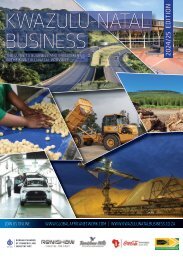Limpopo Business 2016-17 edition
The 2016/17 edition of Limpopo Business is the eighth issue of this highly successful publication that, since its launch in 2007, has established itself as the premier business and investment guide to the Limpopo province. Limpopo is unique in terms of its abundant natural and human resources, and is also one of the key drivers behind the South African economy. This edition of Limpopo Business is officially endorsed by the Office of the Premier of Limpopo.
The 2016/17 edition of Limpopo Business is the eighth issue of this highly successful publication that, since its launch in 2007, has established itself as the premier business and investment guide to the Limpopo province.
Limpopo is unique in terms of its abundant natural and human resources, and is also one of the key drivers behind the South African economy.
This edition of Limpopo Business is officially endorsed by the Office of the Premier of Limpopo.
Create successful ePaper yourself
Turn your PDF publications into a flip-book with our unique Google optimized e-Paper software.
SPECIAL FEATURE<br />
Agriculture makes up 25% of the<br />
local economy, with the value of<br />
the region’s gross production estimated<br />
at R250-million. Burgersfort<br />
is an important town because of<br />
platinum mining.<br />
Mopani District<br />
Giyani is the administrative capital<br />
of the district and is key to the local<br />
economy. The public sector is<br />
one of the largest employers in the<br />
district. The key sectors are agriculture<br />
and mining. Mopani has<br />
an established food manufacturing<br />
industry in canned, preserved<br />
and dried-fruit production and vegetable juices.<br />
Phalaborwa is the gateway to the Kruger National<br />
Park. It has a good airport and is a tourism hub.<br />
Palaborwa Mining Company (Palamin) is the major<br />
economic driving force in the area. State-owned<br />
phosphate and phosphoric acid producer Foskor<br />
is another major employer. Sasol Nitro Phalaborwa<br />
produces phosphoric acid and deflourinated acid.<br />
The Marula Festival is held in Phalaborwa in February<br />
every year.<br />
A subtropical climate and fertile soils combine to<br />
make greater Tzaneen very productive in terms of fruit<br />
and vegetables. <strong>Limpopo</strong>’s second-most populous<br />
city has a population of 80 000. The Letaba Valley<br />
produces a large proportion of South Africa’s mangos,<br />
avocados and tomatoes.<br />
Forty sawmills operate in the area, drawing on the<br />
heavily forested hills around the city. One of the major<br />
road links between Gauteng and the Kruger National<br />
Park also passes through the area, providing excellent<br />
links for tourism and business.<br />
Vhembe District<br />
The Vhembe District borders Zimbabwe and<br />
Botswana. The district’s administrative capital is<br />
Thohoyandou. Vhembe’s vast bushveld supports<br />
commercial and game farming and the district has<br />
considerable cultural and historical assets. The major<br />
economic sector is agriculture, both in terms of<br />
commercial and subsistence farming. Game farming<br />
is a growing subsector, as is eco-tourism. De Beers’<br />
Venetia Mine, situated just west of Musina, is South<br />
Africa’s largest diamond producer.<br />
Situated in the north-east of the province, fairly<br />
close to the Punda Maria Gate of the Kruger National<br />
Park, Thohoyandou is the administrative centre of<br />
Thulamela Local Municipality, Vhembe District<br />
Municipality and the University of Venda.<br />
The Tshivhase tea estates are not far from the<br />
town and a new project is cultivating exotic trees<br />
and ornamental shrubs. The town is on the Ivory<br />
Route and hosts the Venda Cultural Museum. Other<br />
attractions include an ancient baobab tree, the Dzata<br />
Ruins, the Museum of the Drum, the mystical Lake<br />
Fundudzi and Nwanedi Provincial Park.<br />
Waterberg District<br />
The mining sector is the largest contributor to regional<br />
GDP, while agriculture is also significant. Several towns<br />
in the district are located in the mineral-rich Bushveld<br />
Igneous Complex.<br />
The district also features the riches of the Waterberg<br />
Coal Fields, iron ore (at Thabazimbi) and tin and platinum<br />
at Mookgophong. The town of Lephalale is at<br />
the heart of the region’s coal-mining and powergeneration<br />
sectors.<br />
The area around Mokopane is one of the richest<br />
agricultural zones in South Africa, producing wheat,<br />
tobacco, cotton, beef, maize and peanuts. The bubbling<br />
hot springs of Bela-Bela market it as a popular<br />
tourism destination, and the district offers many luxury<br />
golf estates.<br />
19 LIMPOPO BUSINESS <strong>2016</strong>/<strong>17</strong>


















